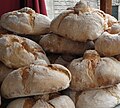Bread in Spain
Bread in Spain plays a fundamental role in the Spanish diet and culinary traditions. Known for its variety and quality, Spanish bread encompasses a wide range of types, each with distinct characteristics, ingredients, and methods of preparation. This article explores the significance, types, and cultural aspects of bread in Spain.
History
The history of bread in Spain dates back to the Roman Empire, when wheat cultivation and bread-making techniques were introduced. Over the centuries, these techniques were refined, and by the Middle Ages, bread had become a staple of the Spanish diet. The Moorish occupation introduced new ingredients and methods, further enriching the Spanish bread-making tradition.
Types of Spanish Bread
Spain boasts an impressive variety of bread, each region offering its own specialties. Some of the most notable types include:
- Barra Gallega: Originating from Galicia, this bread is known for its crusty exterior and soft interior.
- Pan de Cristal: A type of bread with a very crispy crust and an airy interior, similar to ciabatta.
- Hogaza: A round, rustic sourdough bread that is popular throughout the country.
- Chapata: The Spanish version of ciabatta, characterized by its chewy texture and irregular holes.
- Pan de Cea: A traditional bread from the region of Galicia, protected by a designation of origin. It is known for its dense crumb and intense flavor.
Cultural Significance
In Spain, bread is more than just food; it is a symbol of sharing and community. It is present in almost every meal, from breakfast to dinner. The phrase "pan y agua" (bread and water) signifies basic sustenance in Spanish culture. Additionally, special breads are baked for festivals and holidays, such as the Rosca de Reyes for Epiphany.
Bread-Making Process
Traditional Spanish bread is made using basic ingredients: flour, water, salt, and yeast. Artisanal bakeries often use sourdough starters to ferment the bread, a method that dates back centuries. The dough is typically kneaded by hand and baked in wood-fired ovens, which impart a unique flavor and texture to the bread.
Regional Variations
Each region in Spain has its own unique bread varieties, reflecting the local culture, climate, and ingredients. For example, the Balearic Islands are known for their Pan Payés, a rustic farmer's bread, while Andalusia offers Mollete, a soft, round bread.
Conclusion
Bread in Spain is a testament to the country's rich culinary heritage and regional diversity. From the crusty Barra Gallega to the soft Mollete, Spanish breads offer a taste of the country's history, culture, and artisanal craftsmanship.
Bread in Spain
Transform your life with W8MD's budget GLP-1 injections from $125.
W8MD offers a medical weight loss program to lose weight in Philadelphia. Our physician-supervised medical weight loss provides:
- Most insurances accepted or discounted self-pay rates. We will obtain insurance prior authorizations if needed.
- Generic GLP1 weight loss injections from $125 for the starting dose.
- Also offer prescription weight loss medications including Phentermine, Qsymia, Diethylpropion, Contrave etc.
NYC weight loss doctor appointments
Start your NYC weight loss journey today at our NYC medical weight loss and Philadelphia medical weight loss clinics.
- Call 718-946-5500 to lose weight in NYC or for medical weight loss in Philadelphia 215-676-2334.
- Tags:NYC medical weight loss, Philadelphia lose weight Zepbound NYC, Budget GLP1 weight loss injections, Wegovy Philadelphia, Wegovy NYC, Philadelphia medical weight loss, Brookly weight loss and Wegovy NYC
|
WikiMD's Wellness Encyclopedia |
| Let Food Be Thy Medicine Medicine Thy Food - Hippocrates |
Medical Disclaimer: WikiMD is not a substitute for professional medical advice. The information on WikiMD is provided as an information resource only, may be incorrect, outdated or misleading, and is not to be used or relied on for any diagnostic or treatment purposes. Please consult your health care provider before making any healthcare decisions or for guidance about a specific medical condition. WikiMD expressly disclaims responsibility, and shall have no liability, for any damages, loss, injury, or liability whatsoever suffered as a result of your reliance on the information contained in this site. By visiting this site you agree to the foregoing terms and conditions, which may from time to time be changed or supplemented by WikiMD. If you do not agree to the foregoing terms and conditions, you should not enter or use this site. See full disclaimer.
Credits:Most images are courtesy of Wikimedia commons, and templates, categories Wikipedia, licensed under CC BY SA or similar.
Translate this page: - East Asian
中文,
日本,
한국어,
South Asian
हिन्दी,
தமிழ்,
తెలుగు,
Urdu,
ಕನ್ನಡ,
Southeast Asian
Indonesian,
Vietnamese,
Thai,
မြန်မာဘာသာ,
বাংলা
European
español,
Deutsch,
français,
Greek,
português do Brasil,
polski,
română,
русский,
Nederlands,
norsk,
svenska,
suomi,
Italian
Middle Eastern & African
عربى,
Turkish,
Persian,
Hebrew,
Afrikaans,
isiZulu,
Kiswahili,
Other
Bulgarian,
Hungarian,
Czech,
Swedish,
മലയാളം,
मराठी,
ਪੰਜਾਬੀ,
ગુજરાતી,
Portuguese,
Ukrainian
Contributors: Prab R. Tumpati, MD








